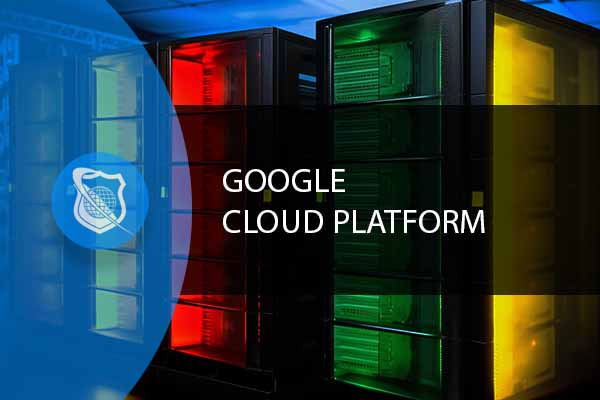When deploying virtual machines on Google Compute Engine (GCE), understanding the available disk types and storage options is crucial. These choices impact the performance, durability, and cost of your cloud infrastructure. This blog post delves into these options, emphasizing the significance of the boot disk and the differences between persistent and local SSD storage options.
Understanding the Boot Disk
Each Compute Engine instance is equipped with a single root persistent disk. This disk contains the operating system image that is loaded during the boot process, setting up the necessary components like networking to get the instance ready for use. The boot disk is a key element of Compute Engine, offering the ability to create snapshots, install software, and ensuring data durability across reboots.
Google Cloud Platform
Ready to master GCP Certification? Our novice-friendly Google Cloud Platform Training, led by expert Joe Holbrook, is your gateway to success. Gain practical knowledge and become a top-notch cloud engineer. Act now!
Persistent Disks: A Closer Look
Persistent disks are network-based storage options that are not directly attached to the compute instance’s host machine. This attribute contributes to their durability; data remains available even if the instance reboots. Persistent disks come in two main types: standard and SSD.
- Standard Persistent Disks offer a cost-effective storage solution, suitable for light to moderate I/O operations.
- SSD Persistent Disks provide higher throughput and IOPS (input/output operations per second), making them ideal for I/O-intensive applications. While faster, SSDs come at a higher cost.
Local SSDs: Speed vs. Persistence
Local SSDs are physically attached to the server that hosts the virtual machine, offering the highest IOPS and throughput. However, they lack persistence; data stored on a local SSD is lost upon instance reboot or termination. This trade-off between speed and data durability is crucial when designing your infrastructure.
Choosing the Right Disk Option
Selecting between persistent and local SSD storage depends on your application’s requirements:
- Persistent Disks are suitable for applications that need data persistence across reboots, such as databases and file servers.
- Local SSDs are best for temporary storage and cache that require high throughput and low latency, where data persistence is not a concern.
Choosing the right disk option for your Compute Engine instances can significantly impact the performance, cost-efficiency, and reliability of your applications. Here are some case examples illustrating how to select the appropriate storage solution based on different scenarios:
Case Example 1: High-Performance Database Server
Scenario: You’re deploying a high-performance database that requires fast read and write operations to handle large volumes of transactions per second.
Disk Option: SSD Persistent Disk
Rationale: SSD Persistent Disks offer high IOPS and low latency, making them ideal for databases that need quick access to data. Their durability and persistence ensure that your database remains available and reliable, even through reboots.
Case Example 2: Data Analysis Workloads
Scenario: Your company runs large data analysis workloads that process temporary datasets. Performance is critical during the computation, but the data doesn’t need to be retained afterward.
Disk Option: Local SSD
Rationale: Local SSDs provide the highest IOPS and throughput, perfect for workloads that require rapid data processing. Since the data is temporary and doesn’t need to persist after the computation, the non-persistence of local SSDs is not a drawback.
Case Example 3: File Server for Shared Access
Scenario: You’re setting up a file server to store shared documents and media that need to be accessible to various users across the company, with moderate read/write operations.
Disk Option: Standard Persistent Disk
Rationale: Standard Persistent Disks offer a cost-effective solution for workloads with moderate I/O requirements. They provide the necessary durability and data persistence for a file server, ensuring that files are accessible even after VM reboots.
Case Example 4: Development and Testing Environments
Scenario: Developers need environments for coding and testing applications, where they can safely experiment and reset the state without worrying about long-term data retention.
Disk Option: Local SSD or Standard Persistent Disk
Rationale: Local SSDs can be used for their high performance, benefiting build processes and temporary databases during testing. Alternatively, standard persistent disks can offer a more cost-effective solution for less I/O-intensive tasks, with the advantage of data persistence if needed for longer-term projects.
Case Example 5: Disaster Recovery and High Availability
Scenario: You need to implement a disaster recovery plan for critical applications, ensuring data is replicated across multiple zones or regions.
Disk Option: Regional Persistent Disk
Rationale: Regional Persistent Disks are designed for high availability and disaster recovery. They automatically replicate data across two zones in the same region, ensuring your applications can quickly recover from failures without data loss.
These case examples demonstrate the importance of aligning your disk and storage choices with the specific needs and objectives of your applications and workloads on Google Compute Engine. By carefully considering factors like performance requirements, data persistence needs, and cost constraints, you can select the optimal disk option to support your use cases.

Google DevOps Engineer Career Path
Targeting the Google Cloud Platform (GPC), this DevOps Engineer training series provides students with both broad and in-depth content designed to ensure you succeed in the role of a Google DevOps Engineer.
Additional Storage Options
Compute Engine also provides other storage solutions, such as zonal and regional persistent disks for higher availability, and Cloud Storage for cost-effective, scalable object storage. These options cater to different needs, from high availability to cost savings, allowing for a tailored infrastructure setup.
Performance Considerations
Performance considerations for disk options in Google Compute Engine (GCE) are critical for ensuring that your applications run efficiently and cost-effectively. The performance of your storage solution can significantly impact your application’s responsiveness, throughput, and overall user experience. When evaluating performance considerations, focus on factors such as Input/Output Operations Per Second (IOPS), throughput, and latency, which are key determinants of how well your storage will serve your application needs.
Input/Output Operations Per Second (IOPS)
IOPS is a measure of how many read or write operations a storage system can perform in a second. It’s a crucial metric for workloads that require frequent data access, such as transactional databases, high-traffic web servers, and data processing applications.
- SSD Persistent Disks are optimized for high IOPS, making them suitable for I/O-intensive applications. They can handle a large number of read/write operations, ensuring quick data access and smooth application performance.
- Standard Persistent Disks offer lower IOPS compared to SSDs, making them a cost-effective choice for workloads with moderate I/O requirements, such as file servers or low-traffic web applications.
Throughput
Throughput measures the amount of data that can be read from or written to the storage system per second. It’s an important consideration for applications that need to move large volumes of data, such as video streaming services, large-scale batch processing, or data backup and recovery solutions.
- SSD Persistent Disks provide high throughput rates, supporting applications that need to quickly access or transfer large files or datasets.
- Local SSDs offer the highest throughput, ideal for data-intensive applications that require the fastest data transfer rates for large volumes of data.
Latency
Latency refers to the time it takes for a storage system to complete a read or write operation. Low latency is critical for applications requiring real-time access to data, such as online gaming, financial trading platforms, and interactive web applications.
- Local SSDs have the lowest latency since they are physically attached to the server that hosts the VM. This proximity allows for the quickest possible data access times, essential for latency-sensitive applications.
- SSD Persistent Disks also offer low latency compared to standard disks, providing faster data access that benefits performance-critical applications.
Balancing Performance with Cost
While performance is crucial, it’s also important to balance it with cost considerations. SSD options, both persistent and local, offer superior performance but at a higher price point. Standard persistent disks, while slower, can be a more cost-effective solution for less demanding applications.
Use Case Specific Considerations
- High-Performance Computing (HPC) and Machine Learning: These workloads often require the high IOPS and throughput provided by local SSDs to quickly process large datasets.
- Databases: Transactional databases benefit from the high IOPS and low latency of SSD persistent disks to ensure fast query responses and transaction processing.
- Content Delivery and Media Streaming: Throughput is a key consideration, making SSD persistent disks a suitable option for efficiently delivering large media files to users.
When selecting disk options for Compute Engine, it’s essential to consider the specific performance requirements of your applications. Understanding the trade-offs between IOPS, throughput, latency, and cost will help you choose the most appropriate storage solution, whether it’s SSD persistent disks for high-performance needs, standard persistent disks for balanced performance and cost, or local SSDs for the highest speed and throughput.

Get Comprehensive Training With Our Kubernetes Certification Training Series
Master Kubernetes with our comprehensive Kubernetes Certification Training Series, which includes a detailed Kubernetes certification path designed for IT professionals seeking expertise in containerization & orchestration for application development and system administration. Enroll now to elevate your cloud skills and earn your CKA & CKAD certifications through our structured Kubernetes certification course.
Leveraging Images for Efficiency
Compute Engine allows the use of images for boot disks, ranging from basic OS images to customized configurations. This flexibility supports various use cases, such as deploying VMs tailored to specific departments or applications, streamlining the deployment process.
Key Takeaways for Your Compute Engine Deployment
- Every Compute Engine instance includes a root persistent disk.
- Choose between persistent disks and local SSDs based on your need for speed versus persistence.
- Explore additional storage options like zonal/regional disks and Cloud Storage to optimize cost and availability.
- Utilize images to efficiently deploy and manage VMs tailored to your specific needs.
Understanding these storage and disk options enables informed decisions, ensuring your Compute Engine deployments are both efficient and cost-effective. Whether you’re preparing for a Google Cloud exam or designing a cloud infrastructure, these insights will guide you towards the best choices for your use case.
Key Term Knowledge Base: Key Terms Related to Google Compute Engine Storage and Disk Options
Understanding the key terms related to Google Compute Engine (GCE) storage and disk options is essential for IT professionals, developers, and anyone involved in cloud infrastructure management. This knowledge aids in making informed decisions about disk types and storage solutions that impact performance, cost, and reliability of cloud-based applications and services.
| Term | Definition |
|---|---|
| Google Compute Engine (GCE) | A component of Google Cloud Platform that provides scalable and flexible virtual machine instances for running applications. |
| Boot Disk | The primary disk that contains the operating system image for a Compute Engine instance, used during the boot process. |
| Persistent Disk | Network-based storage attached to a GCE instance, offering data persistence across reboots with options for standard and SSD types. |
| Local SSD | High-performance, temporary storage physically attached to the server that hosts the virtual machine, offering high IOPS but lacking data persistence. |
| Standard Persistent Disk | A cost-effective persistent disk option suitable for light to moderate I/O operations, utilizing HDD technology. |
| SSD Persistent Disk | Offers higher throughput and IOPS, ideal for I/O-intensive applications, utilizing SSD technology. |
| IOPS (Input/Output Operations Per Second) | A performance metric that measures the number of read and write operations a storage system can handle per second. |
| Throughput | The volume of data that can be transferred to and from a storage device per second, often measured in MB/s or GB/s. |
| Latency | The delay before a transfer of data begins following an instruction for its transfer, crucial for applications requiring real-time data access. |
| Regional Persistent Disk | A storage option that replicates data across multiple zones in the same region, designed for high availability and disaster recovery. |
| Zonal Persistent Disk | Storage that is confined to a single compute engine zone, offering high performance and low latency within that zone. |
| Cloud Storage | Google’s object storage solution for the cloud, offering scalable, durable storage for data archiving, online backup, and cloud-native applications. |
| Snapshot | A read-only copy of a disk at a specific point in time, used for backups and creating new persistent disks. |
| Image | A bootable snapshot of a disk that contains a preconfigured operating system and software, used for creating new VM instances. |
| Machine Type | The virtual hardware configuration of a Compute Engine instance, defining the amount of CPU, memory, and other resources. |
| Data Durability | The likelihood that data will remain intact without loss over time, especially through hardware failures or other disruptions. |
| High Availability | The ability of a system or component to be continuously operational for a desirably long length of time. |
| Disaster Recovery | Strategies and processes for recovering from catastrophic events, ensuring minimal data loss and downtime. |
| Scalability | The capability to handle increasing volumes of work, or its potential to be enlarged to accommodate that growth. |
| Cost Efficiency | The balance between the resource consumption (cost) and the performance or capabilities obtained (efficiency). |
| Data Replication | The process of copying data from one location to another to ensure consistency and reliability across multiple computing environments. |
| Data Persistence | The characteristic of data that remains stored and accessible across sessions and reboots of computing devices. |
| Zonal and Regional Options | Refer to the geographic placement and replication strategy of storage, affecting availability and latency. |
| Object Storage | A storage architecture that manages data as objects, as opposed to file systems or block storage, suitable for unstructured data. |
This comprehensive list of terms and definitions provides a solid foundation for understanding and effectively working with Google Compute Engine’s storage and disk options.
Frequently Asked Questions Related to Google Compute Engine
What is the difference between a persistent disk and a local SSD in Compute Engine?
Persistent disks are network-attached storage that offers high durability and data persistence across virtual machine (VM) reboots. They can be either standard HDD or SSD and are suitable for applications requiring consistent storage availability. Local SSDs are physically attached to the server that hosts the VM, providing higher IOPS and throughput but lacking data persistence across reboots. Local SSDs are ideal for temporary storage needs and workloads requiring fast data access.
Can I convert a standard persistent disk to an SSD persistent disk?
Yes, it is possible to upgrade a standard persistent disk to an SSD persistent disk in Compute Engine. This process involves creating a snapshot of the existing standard disk and then creating a new SSD persistent disk from that snapshot. This method ensures data retention while benefiting from the performance improvements of SSD storage.
How does Compute Engine ensure data durability on persistent disks?
Compute Engine ensures data durability on persistent disks by automatically replicating the data across multiple physical disks in a data center. This replication protects against the failure of any single component, ensuring that your data remains accessible and intact even in the event of hardware failures.
What happens to the data on a local SSD if the Compute Engine VM is stopped or terminated?
Data stored on a local SSD is lost when the VM is stopped, terminated, or moved to another host. Local SSDs do not provide data persistence, making them unsuitable for storing critical data that must survive such events. Instead, they are best used for temporary storage, such as caches or processing workloads that do not require long-term data retention.
Can I use external cloud storage services with Compute Engine for my storage needs?
Yes, Compute Engine VMs can integrate with external cloud storage services, including Google Cloud Storage. Cloud Storage offers scalable, object-based storage with global distribution and redundancy. It’s ideal for storing large datasets, backups, and static files that your Compute Engine instances can access. This integration allows for a flexible and scalable storage solution that can be tailored to specific requirements, such as data archival or global content delivery.

























